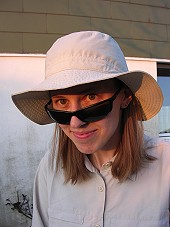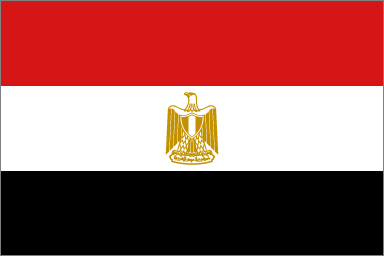
MARTINA'S WORLD TRIP
EGYPT: April 25 - May 18, 2004


(Übersetzungshilfe)
 |
MARTINA'S WORLD TRIP EGYPT: April 25 - May 18, 2004 |
|||||||
 |
||||||||
 |
Your Dictionary
(Übersetzungshilfe) |
|||||||
| Tuesday, May 11th, 2004 - Siwa I | ||||||||
| Tuesday, May 11th, 2004 - Siwa I
We arrived at Siwa Oasis around noon after 4 hours ride on the bus, crossing the Western Desert. Apart from sand, rocks and wild camels there was nothing to see on the way. Before we had left Marsa Matruh, we briefly stopped on the beach just to hold our hands and feet in the Mediterranean Sea for a second. The water was crystal clear and turquoise blue like in a catalogue, although not very warm. Oh yes, what was funny today was another example of how well Egyptians tend to follow the law: Yesterday we had to take a policeman on the bus that was supposed to ‘protect’ us on our way from Cairo to Siwa. It was a very young guy, he honestly looked like maximum 18, and wore a suit that was at least two numbers too large for him. Well, we were not convinced at all that we needed this guy (let alone that he would be able to protect us from anyone) but Vincent told us that these men were allocated randomly and that we had to take him onboard. Today, we were surprised to leave without him but Atif told us that the guy had decided to spend his time in Marsa Matruh visiting friends rather than to come all the way to Siwa with us… and that’s the police! Siwa is located approximately 550 km west of Cairo, near the Libyan border. Until I came here, I always thought an oasis was nothing more than a tiny piece of green somewhere in the middle of the desert. A few palm trees, maybe some water, shadow and food for the desperate wanderer who was lucky to find the oasis existing for real instead of being tricked into death by another mirage in the heat of the desert. Well, although located in the middle of endless sand dunes, Siwa wasn’t especially hot - and it was HUGE: 200.000 people, 300.000 palm trees and 70.000 olive trees sustained by more than 300 freshwater springs and streams. Famous for its dates and olives, Siwa is a sea of green that remained quite isolated from the rest of Egypt until the 1980s when the asphalt road to Marsa Matruh was built. As a result, Siwans still speak their own Berber dialect and have a unique local culture. Upon arrival, we checked in at our hotel and went for lunch. In the afternoon we rented some bikes (yes, me on a bike, imagine!) to go and see some of the sights surrounding the village. First we went to the hill of Aghurmi, 4 km east of the town, to see the ruins of the Temple of the Oracle. The temple was built sometime in the 6th century BC and was one of the six most influential oracles in the ancient Mediterranean. Such was the fame of Siwa’s oracle that it threatened the Persians who invaded Egypt in 525 BC and ended the 26th dynasty. One of the Western Desert’s most persistent and romantic legends is the tale of King Cambyses, the Persian who sent an army of 50.000 men to destroy the oracle and its priests after it predicted a tragic end to the invader. Legend has it that the army was swallowed up in a sandstorm and never reached its destination, thus reinforcing the political power of the Amun priesthood. Trying to find remains of the lost army has been a holy grail of desert travellers for centuries. So far, no trace has been found. After the Temple of the Orcale we continued to the near-by Temple of Amun, which is pretty much totally ruined thanks to an Ottoman governor who blew up the temple in 1896 to get building material. Last but not least, we rode our bikes through the palm groves to a natural spring, called “Cleopatra’s Bath”. The water was pretty clear and we all had a swim in the big pool. Towards the end of the day, we returned the bikes and went to see the sunset close to the saltwater Lake Siwa. Sipping our tea, it was a very beautiful sunset (see picture). Later at night, we went for dinner in one of the best restaurants in Siwa and probably all over Egypt: Kenooz. Although not cheap, the food was marvellous and only the setting of the restaurant was worth coming here. On the way back to the hotel we passed Shali, the remains of a mud-brick fortress in the centre of the town. Built in the 13th century from a material locally known as ‘kershef’, large chunks of salt mixed with rock and plastered in local clay, the labyrinthine buildings orginially rose up to four or five storeys and housed hundreds of people. For centuries, few outsiders were admitted inside. A three-day rain in 1926 was so damaging that the inhabitants abandoned most of Shali. Nowadays only very few buildings around the edges are used and with each rainfall more of this unique structure disintegrates. Two more things to remember about this evening: The strange man on the market square, who tried to follow and touch me (I seriously believe he was mentally disturbed), and the first encounter Sarah and I had with an unkillable cockroach in our bathroom. It wouldn’t drown, it wouldn’t go down the drain, but when I told him I would have to step on him if he didn’t go away, he actually left through the open front door… |
||||||||